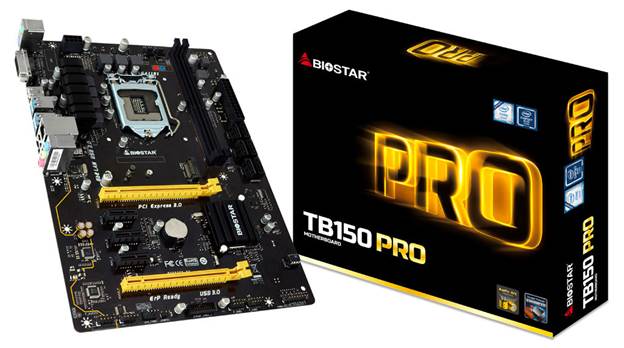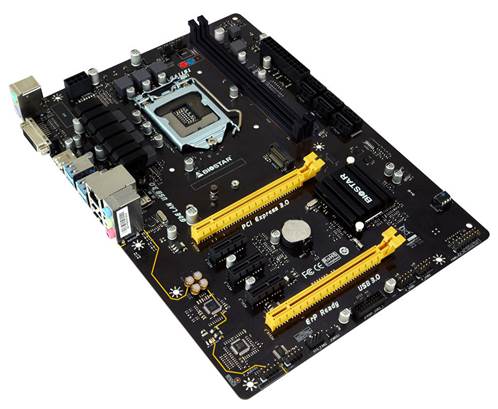Biostar Intros A Motherboard For Cryptomining, The TB150 Pro
Biostar announced its TB150 Pro motherboard, which is targeted at cryptocurrency miners.
Biostar said that this motherboard is designed to be more stable for cryptomining than its other products. Technically, though, any Z170 or X99 chipset motherboard would work better for cryptomining than one with a B150 chipset. The B150 chipset limits the second PCI-E x16 slot to a PCI-E 3.0 x4 connection. This could reduce the performance of the second GPU, but it will likely just be an issue with high-end GPUs.
The TB150 Pro has the standard six SATA-III (6 Gbps) ports and an M.2 Key M slot (32 Gbps) to connect storage devices. The M.2 slot is an excellent addition to the board for gamers, but cryptominers will usually be unable to use it. Biostar connected the M.2 Key M port and the second PCI-E x16 slot to the same HSIO lanes on the B150 chipset, and as a result, only one of these connections can be used at a time.
The board has a mid-range audio solution powered by a Realtek ALC887 codec, which is technically capable of feeding eight individual audio channels. Biostar placed just three 3.5 mm connections on the back of the board, however, which limits the TB150 to just four audio channels and a microphone.
The Realtek ALC887 codec is segmented from the rest of the motherboard, but it does not have an EMI shield. The audio subsystem also uses four high-quality Japanese Nichicon capacitors and should help to improve the audio quality by reducing ripple. Realtek also supplied the motherboard’s RTL8111H gigabit network controller.
There is currently no word on pricing or availability.
| Biostar TB150 Pro | |
|---|---|
| Chipset | B150 |
| CPU Support | LGA 1151 Celeron, Pentium, Core i3, Core i5, Core i7 Up to 91 W TDP |
| Memory Support | 2 x DDR4 2133 MHz (Up To 32 GB) |
| Expansion Slots | 2 x PCI-E 3.0 x16 (Primary Slot x16, Secondary Slot x4 Connection) |
| Storage | 6 x SATA-III (6 Gbps)M.2 Key M (32 Gbps, HSIO Lanes Shared W PCI-E 3.0_2) |
| USB | 4 x USB 3.0USB 3.0 Header2 x USB 2.02 x USB 2.0 Header |
| LAN | Realtek RTL8111H Gigabit NIC |
| Audio | Realtek ALC887 Codec + Japanese Nichicon Capacitors |
| Dimensions | 29.5 cm x 21 cm (W x L) |
| Price | N/A |
Get Tom's Hardware's best news and in-depth reviews, straight to your inbox.
-
jkhoward "The B150 chipset limits the second PCI-E x16 slot to a PCI-E 3.0 x4 connection."Reply
Bandwidth doesn't matter when bitcoin mining. You can run 5 cards on that board without any penalty.
Here is an example of an adapter that is commonly used for these types of systems: https://www.amazon.com/Powered-Extender-Litecoin-Bitcoin-Mining/dp/B00HZ0M9F2/ref=sr_1_2?ie=UTF8&qid=1472596744&sr=8-2&keywords=pci+express+x16+adapter
Here is a supporting article: http://cryptomining-blog.com/1153-checking-out-the-pci-express-x1-x16-usb-3-0-extenders/
With that said, you wouldn't want to run SLI/Crossfire on this system. Mining however is a different story. -
bit_user Bitcoin's fate was sealed when they refused to increase the payload size. I'm still waiting for something else to gain as much momentum as it had.Reply -
framerelay Just an absolete product. I have used the cheapest AMD based boards with simplest 30$ APUs with modern in those days AMD HD78xx GPUs. All that stuff was installed on steel shelf without any boxes, using PCIe extention cords. It was several years ago and it was profitable. I am not sure that right now you could earn enough on mining.Reply

